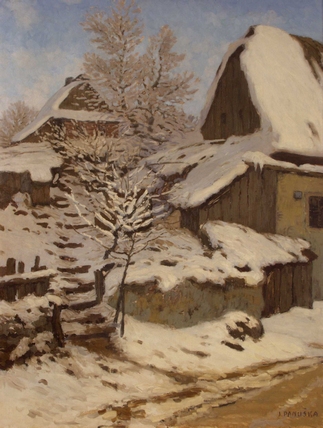Jaroslav Panuška studied with Maxmilián Pirner and Julius Mařák, traveled around Bosnia. His work and life fit into the generation of the 90s, his artistic expression oscillates from early, politically tuned caricatures and illustrations through late decadence and dark figuralism to the later fairy tale. This line of his work, already represented in the Jihlava gallery by the works Čert vyřezává dítě / The Devil Carves a Child (1907) or Mrtvý si jde pro lebku II / The dead man goes for the skull II (1915), is currently often included in exhibitions dedicated to Czech decadence and thus contributes to the reputation of Jaroslav Panuška as its representative. However, in the second line of his work, Panuška was essentially a landscape painter: he soon detached himself from Mařák's romantic symbolism, which appears in earlier landscape-illustrations, and quite soon switched to a realistic form, in which stronger impressionist influences prevail over time. His top paintings tremble, the atmospheric perspective with vistas between the clouds leaves the viewer in no doubt that the landscape was something deeper for the artist and the need for painting in the open air was therefore natural. At first, the paintings focused on painting problems of light, composition, and structure, and later they turned to history, and a number of illustrative reconstructions of old castles, archaeological sites, and battle scenes were created.
The exhibited work Village in winter lacks his famous atmospheric perspective of the winter landscapes of the peak period: it is tighter and, according to the dating given in the gallery catalog, already belongs to his final period. Panuška was famous for painting his winter landscapes directly in the open air, regardless of the perceived cold. This created a number of winter landscapes that are scattered in gallery collections in Eastern Bohemia and the Vysočina region. The work of the month of december, Village in winter, is somewhat different from them – on the one hand due to the tightness of the composition, but above all the color, which lacks his atmospheric violet tinge of the receding air mass, but also the feeling of an open landscape and the associated solution to painting problems of light and shadow. The mood of the painting favors the pensive tone of a winter corner, shrouded in light fog.
Lucie Nováčková
